#california gold rush
Text
Milestone Monday
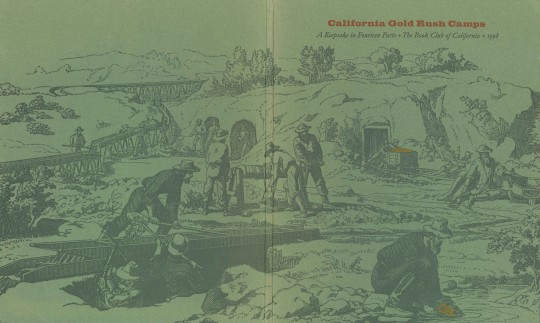
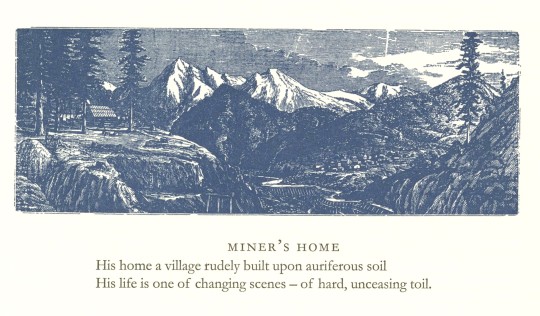


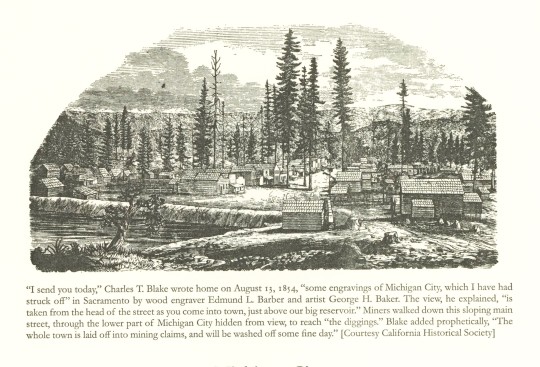
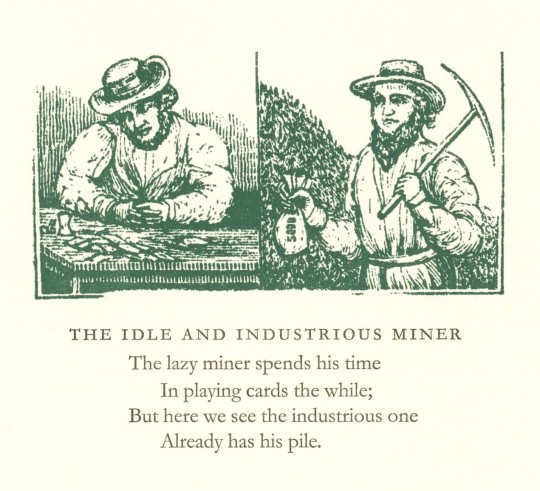
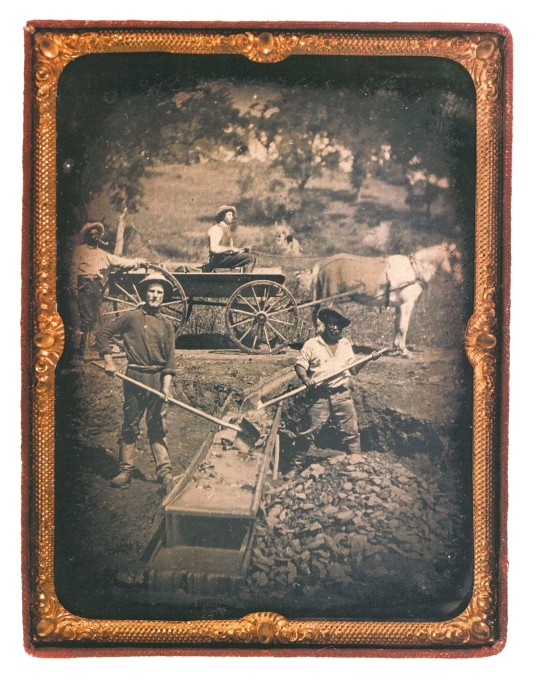
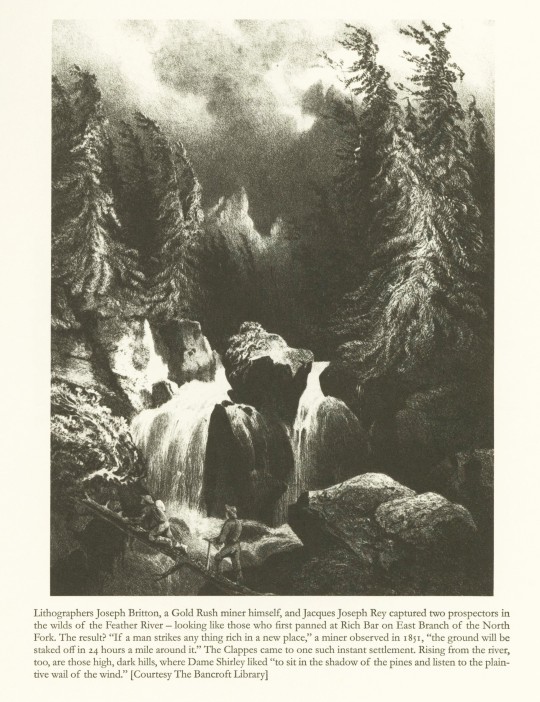

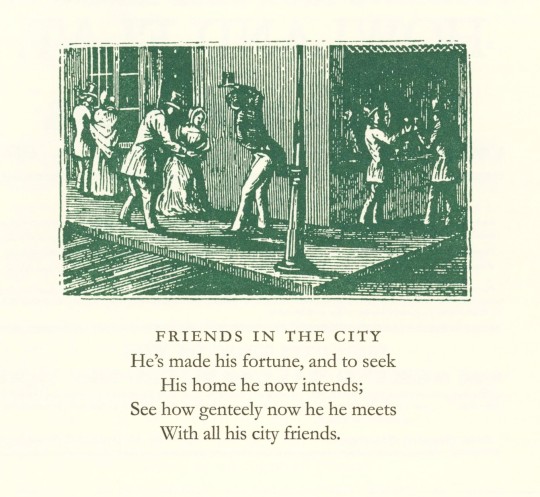
February 5th marks the anniversary of the discovery of the largest alluvial gold nugget in history, known as “Welcome Stranger.” The nugget was found in 1869 by miners John Deason and Richard Oates just outside of Dunolly, Australia. It weighed just under 193 pounds earning the miners roughly £9,381 (equivalent to around A$743,000 today). A little over 8,000 miles away, California was winding down its famed gold rush that forever altered the area’s landscape, societal growth, and indigenous communities.
California Gold Rush Camps: A Keepsake in Fourteen Parts published in 1998 by The Book Club of California documents the lives of miners and the camps that shaped California in the latter half of the 1800s. The keepsake contains fourteen folders, each highlighting the history of a camp that played a notable role in the gold rush. The text is accompanied by color illustrations from Life Among the Miners published by Hutchings & Rosenfield in 1854, sketches published in local magazines and newspapers, lithographs, and a daguerreotype. The series was edited by Robert J. Chandler and designed and printed by Patrick Reagh Printers, Inc.
In alignment with their commitment to sharing California history, The Book Club of California presented portions of this publication at the 1998 Western History Association annual meeting. California Gold Rush Camps: A Keepsake in Fourteen Parts is part of an extensive collection of The Book Club of California materials held within Special Collections. This book is another gift from our friend Jerry Buff.
View other posts on gold mining.
Read other Milestone Monday posts here!
– Jenna, Special Collections Graduate Intern
#milestone monday#welcome stranger#gold nugget#gold rush#gold mining#California Gold Rush#California Gold Rush Camps#mining camps#The Book Club of California#Life Among Miners#daguerreotype#Patrick Reagh Printers#fine press books#Jerry Buff
28 notes
·
View notes
Text

“The Ghost Town of Midas”
In the hills about Putnamville CA, just near the Tule River lies the remains of a small town. This was the community of Midas.
This small establishment was created in the 1850s during the rise of the prospectors during the California Gold Rush. It was a lone trapper who discovered bits of gold in the river and proclaimed the land had “the Golden Touch of Midas.” It had a boom period, but after that there were new opportunities back in the valley that would make the towns folk leave. It became a quiet ghost town, but became a popular hideout for bootleggers and rum runners.
Though it’s quiet again, there are mysteries about the towns sudden end. As said earlier, there were new opportunities in farming and trade in towns like Putnamville. However, there were rumors of something else that drove the townsfolk away. According to some of the late rumrunners, they recall seeing a large creature or two stalking them. Encounters range from watching said creature to attacks with large rocks and blood curdling screams. On one night alone, a “battle” took place between a group of the runners and these creatures, leading to claw marks and bullet holes on the buildings. Even today, ranchers note that their animals would avoid the town area as if something lives there, though they never saw the root of this fear. Maybe it’s a mountain lion den. Who knows?
To this day, there are no clear answers what happened in Midas. Folks around here just claim the bootleggers were just having a wild night with their guns and encountered a mountain lion. That’s the accepted story. While others believe the monster (whatever it is) may be real. We’ll probably never know. The real question is this:
Are you willing to visit Midas? If so, what will you see?
—————————-
I wrote this story as a new bit of Life Beside the Tracks lore. I hope y’all enjoy it.
#digital illustration#kcvulpinestudios#digital art#life beside the tracks#ghost town#halloween#Halloween vibes#creature#cryptid#cryptozoology#scary story#gold rush town#night#spooky#moon#California history#California#california gold rush#ghost story#monster story#spooky vibes#digital artist#digital artwork#digital landscape#building art#buildings#please like and share
12 notes
·
View notes
Text
Westward Ho! Cincinnati Men Caught The California Gold Fever In 1849
It took a long time in 1848 for news to travel from California to Cincinnati. Gold was discovered at Sutter’s Mill, northeast of San Francisco, in January of that year, but Cincinnatians remained blissfully unaffected by gold fever until the middle of September.
By December 1948, Cincinnati merchants were placing advertisements in the local papers, offering camping and mining supplies to young men heading westward. As the new year of 1849 dawned, Cincinnati was fully possessed by visions of gold. Local newspapers printed dozens of announcements similar to this one, from the Commercial Tribune [23 February 1849]:
“A party of enterprising gentlemen of this city, completed their arrangements yesterday, packed up their trappings, and took passage on the steamer Chief Justice Marshall, for California. They design to sail from New Orleans, and either cross the Isthmus, or take the land route, via City of Mexico. The choice of these routes depends on contingencies. The party is composed of the brothers Moses, Mr. Collins, jeweler, and Messrs. Varney, Light, Vater, and the brothers Fagan.”
The Cincinnati Commercial [9 March 1849] reported on a company of 20 Cincinnatians setting out on the overland route to California, with a plan to cover expenses by selling gunpowder:
“They take with them one hundred kegs of powder, which on their arrival will be distributed, five kegs to each man – thus furnishing each a handsome capital to start on.”
In April, the “Independent Pacific Dispatch Company,” composed of 25 Cincinnati men, departed, also on the overland route. They loaded their pack mules onto the steamboat John Hancock, bound for Independence, Missouri, where they would commence hoofing across the continent.
As a major port along the Ohio River, Cincinnati not only witnessed local boys departing for the gold fields, but steamboats full of similarly determined young men passing through town. The Commercial Tribune [14 April 1849] was agog at the mass of virility floating westward down the Ohio:
“The tide of emigration to California is, in its extent, beyond all historical parallel; and will, in future times, stand prominent as the great event of the Nineteenth Century.”
Many of those adventurers, especially those from rural districts, stopped in Cincinnati to stock up on the supplies required to operate a basic gold-mining operation. Our shopkeepers were delighted to welcome the business. Gustav Sellin, purveyor of tin goods, advertised a gold-washing machine “of the most ingenious construction,” along with wash bowls, scoops and strainers. Philip Pike touted his “Imitation French Brandies, Holland Gin, Rum and Wines,” guaranteeing that a thousand-dollar investment in his beverages could be recouped for twenty times that amount in the thirsty gold fields. Miller Cornelius Sanders Bradbury boasted about his novel “steam-dried flour” warranted not to sour or get moldy for two years – ideal for the long trail westward.
Some Cincinnati businessmen just surrendered and joined the migration. Real estate mogul Thomas Hurst put a flour mill out near Sedamsville up for sale along with eight houses in the city. He was, as they say in the trade, a motivated seller. He closed his advertisement with this explanation:
“As I am making preparations for California, application should be made soon.”

Once folks arrived in California, they often discovered that panning for gold was not exactly as advertised. For instance, Benjamin Cory (Miami University Class of 1842, Medical College of Ohio Class of 1845) was busily engaged trading clothing to Native Americans in exchange for gold. Called to attend to a wealthy ranchero, Doctor Cory found himself trapped. In a letter home, Cory complained:
“My patient is quite smart this morning; he says I shall not leave him till all danger is over. ‘Charge what you please, Doctor,’ he says, ‘and it shall be paid; here is my ranch, with its horses, cattle, &c. &c. and I have a good large bag of gold.’ I am sorry, dear brother, that I ever had doctor stuck to my name; it is more trouble than profit; I am vexed to death; I tell people that I can get more gold in the mountains by digging and trading, than my conscience will permit me to charge my patients.”
Doctor Cory ended up doing okay for himself. The 1909 Miami University alumni directory notes that, before he died in 1896, he was elected to the first legislature of the new state of California in 1850 and had a distinguished medical career in Santa Clara and San Jose.
Joseph Talbert, a carpenter, who left Cincinnati in February 1849, wrote home that his traveling party of fifty had arrived safely in the gold fields. Talbert, however, after trying to mine gold for a couple of weeks, learned he could make more money as a carpenter, building cabins and gold-washing sluices than he could actually trying to find gold.
The Guysi brothers quit their jobs at B.F. Greenough’s lamp oil distillery on Main Street and endured a sea voyage of 160 days to round the tip of South America. They arrived in a San Francisco of 30,000 souls mostly housed in tents and suffering from dysentery. The only water available was polluted with copper, a spot of ground large enough to pitch a tent rented for $150 a month, and gambling was rampant. At least one of the brothers, Jacob, stuck it out; he was buried in the hills overlooking San Francisco Bay when he died at age 79 in 1906.
Joe Heywood had a solid career and sterling prospects here in Cincinnati. He was a butcher by trade, and regularly made the newspapers for the quality of his provender and the skill with which he decorated his shop. He was repeatedly referred to as a very handsome man who cut a dashing figure as a volunteer fireman. He was also known as a dependable “b’hoy” – a tough character – in the days when volunteer fire companies battled over which would put out the fire and collect the insurance money. Still, the Cincinnati Commercial of 9 January 1849 recorded the westward emigration of Heywood, along with Mathias Oliver, James Wilson, Alexander Burns and James McAlpin, all stalwarts of the “Rovers” fire company.
While most young men trudged west in hopes of sending pounds of bullion home, Heywood had no intention of digging anything once he got to California. Instead of packing a pick and shovel, Heywood had 1,500 cards printed to announce his business as a butcher and provision merchant. He seems to have succeeded admirably. After a sea voyage of 156 days, Heywood arrived in San Francisco and set up shop. A letter from a fellow firefighter reported that Heywood replicated the annual Cincinnati Christmas meat parade at his shop that December. Heywood himself wrote a long letter home describing his adventures aboard the ship and promising to write as soon as he could to “Lizzy.” He must have been persuasive. Joseph Heywood and Miss Eliza L. Hensley of Cincinnati were joined in matrimony on 1 July 1856 at San Francisco’s International Hotel.

7 notes
·
View notes
Text
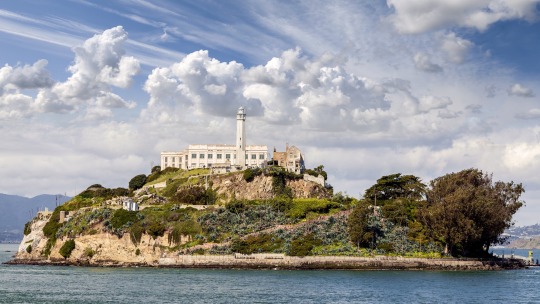
Alcatraz Island still draws tourists for its history as a federal penitentiary. But it also has a rich past as little-known military base, erected to guard against foreign invasion. Image Credit: Mbprojekt Maciej Bledowski, iStock
Ground-Penetrating Radar Reveals Military Structures Buried Beneath Alcatraz Penitentiary
Using non-invasive techniques, archaeologists have confirmed the presence of a coastal fortification beneath what was once the prison’s recreation yard.
— By Katherine J. Wu, Published March 4, 2019 | August 02, 2023
Alcatraz might be best known as a popular tourist destination, the site of the former high-security prison that once held Al Capone. But a team of archaeologists has now unveiled new evidence of this San Francisco Bay island’s often overlooked military history.
In the study, published last Thursday in the journal Near Surface Geophysics, researchers used non-invasive technologies to pull back the curtain on a stunningly well-preserved 19th century coastal fortification that lies beneath the ruins of this infamous federal penitentiary. The work confirms that while prison construction in the early 1900s destroyed much of the former military installation, several structures were buried more or less intact, enshrining a critical sliver of Alcatraz’s colorful past.
“This really changes the picture of things,” says study author Timothy de Smet, an archaeologist at Binghamton University. “These remains are so well preserved, and so close to the surface. They weren’t erased from the island—they’re right beneath your feet.”
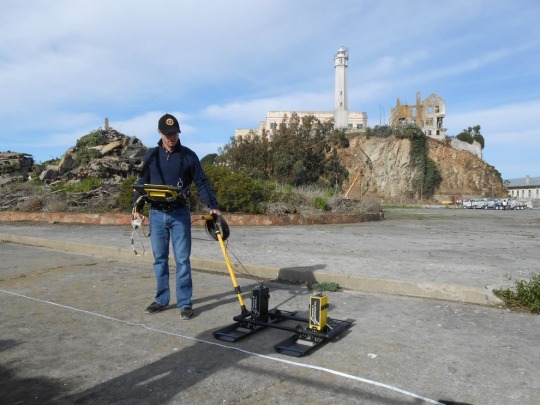
Study author Timothy de Smet used non-invasive techniques to create a subsurface map of remains of Alcatraz Island's former military fortification. Image Credit: Timothy de Smet, Binghampton University
Prior to the mid-1800s, Alcatraz Island was a barren strip of land capable of supporting little more than a raucous population of seabirds. But in the wake of the California Gold Rush, the United States government looked to the rocky outcrop as a potential military base to protect the newly bustling city from foreign invasion. Over the next several decades, a stone- and brick-based fortification was erected, then rebuilt as earthen structures better equipped to handle erosion. But Alcatraz struggled to keep pace with the rapid changes in artillery during and after the Civil War era, and by the late 1800s, the island’s defenses were essentially obsolete. Military pursuits on Alcatraz were abandoned shortly thereafter.
When the island’s prison was erected around the turn of the 20th century, little physical evidence of its former architecture remained—or so many thought. The new study, led by de Smet, says otherwise. To look beneath the surface, the researchers deployed ground-penetrating radar, which pulses electromagnetic waves into the earth, returning signals that can visualize remains without excavation. The strategy uncovered a labyrinth of subterranean structures, including an earthwork traverse, a kind of defensive trench, running beneath the penitentiary’s former recreation yard.
“Below the Surface, Alcatraz is Still Full of Mysteries”
“This really reinforces what several historians and archaeologists had long suspected,” says study author and Alcatraz historian John Martini. “Up until this point, we had nothing to go on except for a few visible trace remains and maps—and a lot of suspicion.”
In a way, Martini says, the findings reflect just how limited real estate was on Alcatraz, which clocks in at less than 50 acres. “On a small island, there’s only so many places you can build,” he says. “And it’s unlikely they went to the trouble of demolishing all this stuff.”

A 15-inch Rodman cannon and its gun crew, 1869. These were the largest guns mounted on Alcatraz. Image Credit: National Park Service, Golden Gate National Recreation Area
Because they’re both sensitive and non-destructive, techniques like ground-penetrating radar are crucial for these kinds of investigations, and can complement historical records that survived the era, says Jolene Babyak, an Alcatraz historian who was not involved in the study.
With these results in hand, de Smet and his colleagues plan to continue archaeological investigations under Alcatraz. Going forward, only time will tell what this rock will reveal, Martini says. “Below the surface, Alcatraz is still full of mysteries,” he says. “There’s still a whole lot to be learned.”
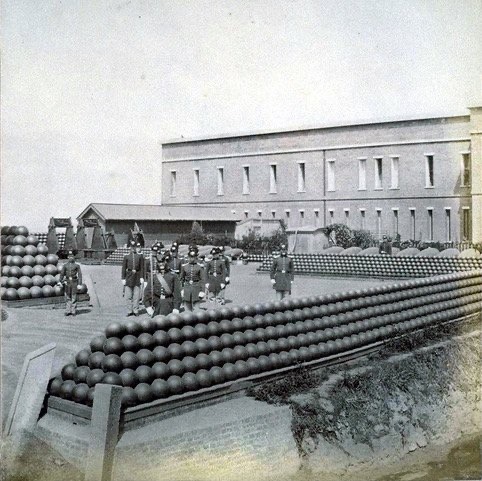
Soldiers posing in the island’s ordnance yard. A brick Citadel capped the summit of Alcatraz. 1869. Image Credit: National Park Service, Golden Gate National Recreation Area
#NOVA | PBS#Ground-Penetrating Radar#Military Structures#Alcatraz Penitentiary#Non-invasive Techniques#Archaeologists#Coastal Fortification#Tourist Destination#High-Security Prison#Al Capone#San Francisco Bay#Military History#Near Surface Geophysics#Timothy de Smet#Binghamton University#California Gold Rush#Civil War Era
3 notes
·
View notes
Text
Another great book about the lead up to the California Gold Rush, mentioned in the Planet Money and Indicator podcast episode about the US paying off all of its debt
2 notes
·
View notes
Text
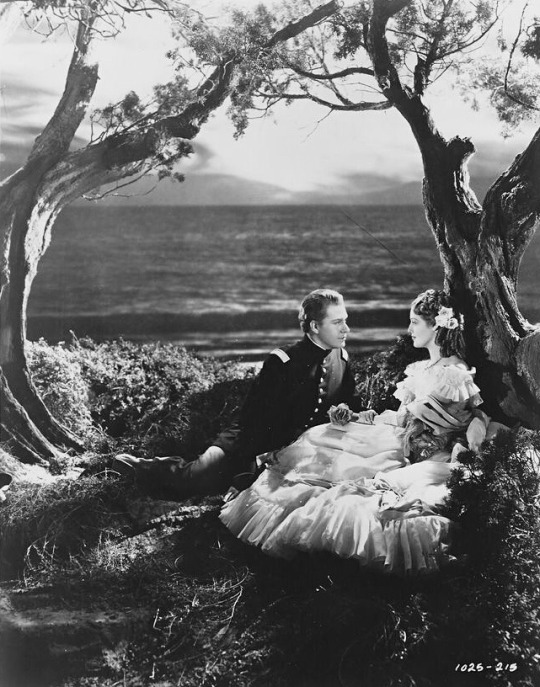
Jeanette MacDonald and Nelson Eddy in The Girl of the Golden West 1938 🌾🌤
#old hollywood#beauty#jeanettemacdonald#nelson eddy#western#musicals#California gold rush#1840s-50s#vintage singers#romance
7 notes
·
View notes
Text
Gold Mining in Columbia, California
Planning to travel from San Francisco to Yosemite, I was excited to add Columbia State Historic Park to my itinerary. Imagining what it would have been like to live during the Gold Rush of the 1800s, I was looking forward to strolling the streets and exploring its old restored buildings.
Located off of Highway 49 near the Sierra Nevada Mountains, Columbia was once a vibrant town that drew a…

View On WordPress
#1800s#attractions#blacksmith#Broadway Street#California#California Gold Rush#City Hotel#Columbia#Columbia Gazette#Columbia Museum#Columbia State Historic Park#Eagle Cotage#Fallon Hotel#fire engine#ghost town#gold mine#Gold Rush#Gold Rush Days#history#horse drawn stage coach rides#ice cream store#mercantile#Mining Town#National Historic Landmark#panning gold#restaurants#restored#saloon#Sierra Nevada Mountains#stores
0 notes
Text
Lmao reading about a San Francisco newspaper that complained about the gold rush that everyone was doing it and not other things got shut down because all its employees went to mine gold
0 notes
Text
California Gold Rush: Journeying West in Search of Riches
California Gold Rush: A timeless testament to human ambition and adaptability. A beacon of hope, it unleashed prosperity and innovation, shaping the Golden State's bright future. #CaliforniaGoldRush #GoldenOppotunity
In the heart of California’s rugged landscape, an irresistible siren call echoed through the canyons and valleys, drawing pioneers from every corner of the globe. The California Gold Rush, a euphoric chapter in human history, ignited a spark of relentless ambition that blazed across the Wild West. It was a riveting era of dreams forged in gold, where fortunes were won and lost, and the spirit of…

View On WordPress
#Boomtowns#California#California Gold Rush#Changed History#Economic Impact#Entrepreneurial Spirit#Fortune Seeker#Glory#Gold Fever#Golden#Innovation#Legends#Rags to Riches#Striking Gold#Trailblazing Era#Untold Story
1 note
·
View note
Text

Ox in the Culvert by Gerald Brence
Set off on a life-altering journey and defy the allure of the California Gold Rush with Texas Rangers Ray Andrew and Tom Jenkins in “Ox in the Culvert” by Gerald Brence. Brace yourself for an unforgettable story filled with bravery, loyalty, and surprising turns.
Experience the Wild West like never before. Grab a copy at www.geraldbrencebooks.com.
#Gerald Brence#Ox in the Culvert#ReadersMagnet#Historical Fiction#California Gold Rush#Western Adventure#Wild West
0 notes
Text
The Gold Rush History In California | Visit El Dorado
The California Gold Rush began in 1848 and brought an influx of people to the western frontier seeking fortune. It is estimated that over 300,000 people traveled to California during this time. Many miners struck gold, but some made their fortune by supplying mining camps with food, tools, and equipment.
0 notes
Text

1 note
·
View note
Text
So in 4th grade we were doing our history unit on the gold rush and one of the assignments was to make up a story about how each mining town got its name. I got Auburn and was so happy because I already knew what I was gonna write and did it all at home so no one knew what I doing. Everyone went before me (I think my teacher did that one purpose) and it was mostly the same story about how somebody with the towns name found gold and the town was named after him. Then I went. My story started out normal a guy named Will was traveling around California looking for gold and stopped for water at a creek and found a giant cache of it and the bottom of this creek so he started mining and eventually a town was built around it and he was the mayor and town was named something like Goldcreek or something like that. (I didn’t stop there) Well then this group of robbers heard about how much gold Will had in the safe in his house and they made a plan to rob for everything that he was worth. Will had somehow got wind of there plan and made one of his own. So the men wait and once they see Will leave his house and go all the way to the end of the town they sneak into his house but when they get to his safe there’s nothing there and they find themselves locked in (This is where my teacher started getting worried). It turns out the night before Will had called a town meeting while they were asleep and told them his plan and had them evacuate. And while he was making his way across town he was lining the whole place with gun powder leading back to his house which he had rigged with TNT. Once he made sure they were in the house he lit the fuse and the whole town burned to the ground with the men still in the house. (At this point I had my whole classes attention) I took a dramatic pause here before I continued. I kept going though and the last page was Will with one of his friends looking over a hill at the town on fire and deciding to rename it Auburn because the flames were so beautiful.
I think I made my class scared of me with my Arson/Murder story. No one was expecting the end and it was so fun to read that to them. My teacher looked so defeated but I got A.
#elementary school stories#auburn#california#california gold rush#mining#mining towns#They definitely talked about me in the teachers lounge#the school was small i really stood out#it was so worth it#they should have known#its really there fault
1 note
·
View note
Text
Great tales of the Gold Rush
0 notes
Text
I am perfectly normal about the Psychonauts timeline
Spoiler warning for...everything.
As I was playing Psychonauts 2, I had a vibe that Ford and the Psychic Seven were active during the late 1920s, early 1930s, mostly because of the Model T Ford in Cruller's Correspondence, but also because of the biplane in the diorama of Ford fighting Maligula from Fatherland Follies. But there were some issues with that - namely the Feel Mobile which resembles more a model of van released around 1964. I feel compelled to mention it looks like the Motherlobe is trapped in the 70s, technology-wise.
So I looked up the timeline on the Psychonauts fandom wiki, as well as the blurb from Psychonauts about the history of Whispering Rock. And while clicking through the wiki, I found a copy of the Li-Po document, which contains the following line:
[...] when [Ford Cruller] was [...] away fighting for the Lincoln Brigade in the Spanish Civil War [...]
Firstly, based.
Secondly, that means Ford had to be at least 16* by 1937 (when American volunteers were sent to Spain). At least if we are to believe that this...very specific part of the Li-Po document is still canon. Which...I mean, we could. We know Ford was already an adult when he assembled the Psychic Seven, but we don't know how old he was. From the looks of him in the mental vaults and illustrations, he was definitely older than 16 (considering the full moustache). Meaning that it is possible Ford spent his younger years fighting in the Lincoln Brigade, then when he matured started looking more into his and others' psychic powers.
Possible? Yes. Plausible? Ehhh...considering the story of Psychonauts 2 is deeply tied to the trauma the Psychic Seven endured surrounding the Grulovian Civil War then the Deluge of Grulovia, I doubt that Ford's previous involvement in a very bloody battalion (22.5% of Lincoln Battalion fighters died in the Spanish Civil War) would have gone unmentioned. Since it makes no appearance in Psychonauts 2, I think it's safe to say it's no longer canon.
So where does that leave us? With the only statement from the devs (specifically Tim Schafer himself) that points us towards a date for the game's events:
"We think of it as taking place in the 80's but not necessarily the 80's, in case we need a piece of technology that we're stealing from the 90's."
So...that leaves us with a year range of 1980 to 1999. However, if technology is an issue (specifically, taking place during the 80s but needing some tech from the 90s), that means the game probably takes place in the late 80s, early 90s. I interpret this as being between 1987 and 1993. So, we've narrowed it down! Based on my arbitrary definition of "late" and "early"!**
Is there any way to narrow it down further? Unfortunately, not from what I can find - the tech we see in the Motherlobe is more reminiscent of the 60s and 70s (the computers we see on peoples' desks and in Sasha's lab look akin to a Xerox Alto, which came out in 1973), and I don't know enough about the history of other technology we see in-game to infer information about the timeline. If someone else has knowledge about things I may have missed that point us towards a date, please reblog and let me know!
Now, before I get into what I see as the timeline, I do want to address Maloof's line when you release him from the GPC.
"Nah, the staff hasn't put any kids in the GPC since the fifties."
Which goes against the timeline written on the log in the parking lot (which states that Whispering Rock Summer Camp was only created 5 years ago). I'm leaning more toward the written lore, since it's entirely possible Maloof is misinformed. After all, this is his first time at the camp. It's entirely possible Bobby (or another camper) has been lying to Maloof about the history of the staff's use of the GPC. For this reason, I'm disregarding this conflicting bit of evidence.
So! On to the actual timeline - at least, what I think it is. Starting from the beginning and working our way to the present day. I will represent the dates as a range, so "1987 - 1993" means "between 1987 and 1993." It doesn't mean that whatever event took place took that long, just that it happened at some point within that range. Good? Good! Let's go.
Brick's Speculative Psychonauts Timeline
1487 - 1493: A psitanium meteor strikes the area that will eventually be known as Whispering Rock, leaving behind a psitanium deposit.
1787 - 1793: A local indigenous group starts working with the psitanium, creating the arrowheads found in the first game, and names the area Whispering Rock (just, in their language, not English)
1887 - 1893: The mining town of Shaky Claim is established as part of the gold rush, except they're mining for psitanium. The psitanium deposit severely worsens the mental health of the people there.
1888 - 1894: The first case of 'Paranormal Hysteria' diagnosed in Shaky Claim.
1912 - 1918: Houston Thorney constructs Thorney Towers Home for the Disturbed. Ford Cruller is born.
1927 - 1933: Houston Thorney commits suicide. The town's population is less than the amount of patients in Thorney Towers.
1932 - 1938: Thorney Towers Home for the Disturbed is closed but some patients still remain. The remaining residents of the valley leave and the area is flooded, resulting in Lake Oblongata.
[At some point, Ford assembles the Psychic Seven]
1967 - 1973: The Psychic Six fight Maligula. Grulovia is flooded then trapped below the frozen floodwaters. Helmut Fullbear is presumed dead. Shortly thereafter, Ford uses the Astralathe to modify the memories of Lucretia and Augustus, then to break his own mind.
[At some point, Charlie Psycho Delta is established then swiftly abandoned]
1982 - 1988: Whispering Rock Summer Camp is established.
1987 - 1993: The events of Psychonauts, Psychonauts: The Rhombus of Ruin, and Psychonauts 2 take place all within about a week (and that's being generous).
So there! That's what I think the timeline is. Again, if you have any feedback or want to point out something I missed, please let me know! I'm new to the games/lore/fandom so 'tis entirely possible!
The implications of this timeline are...interesting. The fact that during the fight with Maligula, something that was supported by multiple countries, they're using planes from the 1910s when it's at least 1967...the world of the Psychonauts isn't less technologically advanced - they have a jet that rivals ones from 2024! So I have no clue what that biplane is doing in Gristol's memory of the fight with Maligula. Unless we consider Gristol an unreliable narrator for that detail - but even then I'm unsure why he wouldn't have assumed they were using modern technology...? IDK. It's weird.
Anyways, if you got this far, thanks for reading! I'm flattered. I always love picking apart lore and timeline details like this, no matter the fandom I'm in. So consider this my hello to the Psychonauts fandom :-)
*According to the Wikipedia page for the Lincoln Battalion, that's probably the youngest any American volunteers were.
** The way I see it: if it ends in 1/2/3, it's early. If it ends in 4/5/6, it's mid. if it ends in 7/8/9, it's late.
#my dad is a warplane nerd and he helped me identify the biplane#irl biplanes like that were used as late as the 1940s since they had more manoeuvrability than the faster jets#but by the 60s/70s there were definitely a variety of planes that would fill the 'slower but better movement' niche#and it cant be because grulovia doesnt have the tech - cause the psychic six weren't working with grulovia !#they were called in by the international community !!!#so for some reason the international community gave them planes that were at least twenty years old to fight this new terrifying foe !!!!!!#what is going on !!!!!!!!!!!#anyway. i was having a hella breakdown (/positive) over this last night. but putting in in clean form like this helps me figure things out-#-in my brain#also the fact shaky claim was established as part of the gold rush implies a location somewhere on the west coast#considering the devs are in california im guessing whispering rock is also in california#psychonauts#psychonauts rhombus of ruin#psychonauts 2#brick wall#ford cruller#because i talk about him a decent amount
24 notes
·
View notes
Text

“Map of North America and the gold region with routes,” an 1849 map showing overland journeys to the Pacific. From our online catalog.
26 notes
·
View notes